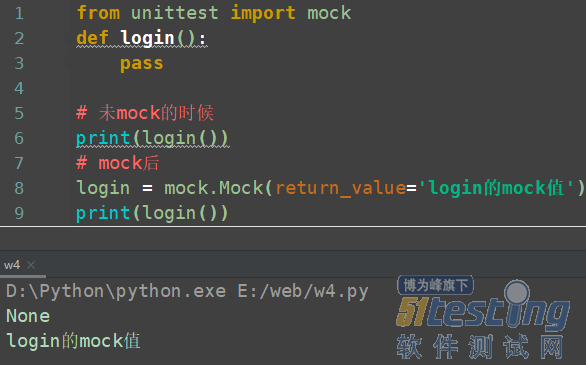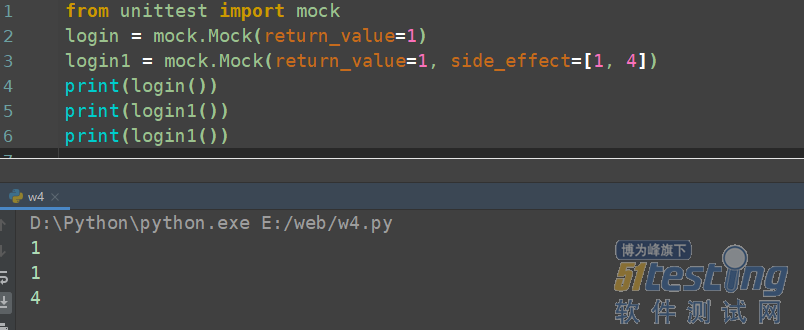前言
在做接口测试的过程中,接口还没有开发完成呢,领导就让介入测试,刚开始小伙伴们肯定会懵,接口都没有开发完成,怎么测试?有的状态不容易构造目前接口没有办法实现,这个时候怎么测试?这个时候就要引入新的知识点---mock。
mock
什么是mock?mock测试就是在测试过程中,对于某些不容易构造或者不容易获取的对象,用一个虚拟的对象来创建以便测试的测试方法。在工作中如果在接口没有开发完成时,也可以进行来模拟接口的返回数据从而验证接口的正确性。
mock需要场景
工作中,为了节约项目时间,开发测试可以进行同步进行,当开发没有完成接口时,测试人员可以通过mock来模拟接口返回数据内容。
模拟暂时无法实现的功能:比如真实的支付功能。
测试覆盖内容,当我们执行接口想要模拟状态400、500的场景,这个时候也可以通过mock。
python中的mock
python中有多重执行mock的方法,其中mock模块在python3.3以上版本已经内置到单元测试unittest中,python3.3以下的版本需要通过pip install mock的方法进行安装。
mock参数
mock在使用过程中需要最常用的3个参数。
name:表示mock的名称。
from unittest import mock result = mock.Mock(name='mock的名称') print(result) # 结果: <Mock name='mock的名称' id='2721150378120'> |
return_value:表示mock的值。
side_effect:表示mock需要调用的对象(当使用return_value和side_effect值同时存在时,优先返回side_effect的值)。
unittest.mock()
这里安静举一个天气的例子进行实现,测试查询天气这个接口,最近上海都没有雪,那么我怎么去模拟雪这个场景?需要等到真正下雪的那天才可以吗?这里通过unittest.mock的方法。
import unittest from unittest import mock class Test01(unittest.TestCase): def weather(self): '''天气接口''' # result = {'result': "雪", 'status': '下雪了!'} pass def weather_result(self): '''模拟天气接口返回值''' result = Test01.weather(self) if result['result'] == '雪': print('下雪了!!!') elif result['result'] == '雨': print('下雨了!!!') elif result['result'] == '晴天': print('晴天!!!!') else: print('返回值错误!') return result['status'] def test_01(self): '''模拟下雪天场景''' mock_xue_result = {'result': "雪", 'status': '下雪了!'} # 使用mock库进行模拟 Test01.weather = mock.Mock(return_value=mock_xue_result) statues = Test01.weather_result(self) self.assertEqual(statues, '下雪了!') def test_02(self): '''模拟下雨天场景''' mock_yu_result = {'result': "雨", 'status': '下雨了!'} # 使用mock库进行模拟 Test01.weather = mock.Mock(return_value=mock_yu_result) statues = Test01.weather_result(self) self.assertEqual(statues, '下雨了!') if __name__ == '__main__': unittest.main() |
通过执行发现,我们想要的下雪天气已经模拟成功了,说明当查询天气接口返回为雪的时候,就代表会下雪了。这样就不用在等到下雪的时候进行测试这个接口了。
mock.patch()
mock.patch()是mock的一个装饰器方法,其中patch的值表示写入需要mock的对象,还拿天气举例子,这里的patch的参数就需要填写天气的接口,需要通过python调用的方式进行填写天气接口。
# w1.py def weather(): '''天气接口''' pass def weather_result(): '''模拟天气接口返回值''' result = weather() if result['result'] == '雪': print('下雪了!!!') elif result['result'] == '雨': print('下雨了!!!') elif result['result'] == '晴天': print('晴天!!!!') else: print('返回值错误!') return result['status'] |
通过mock.patch()装饰器进行来mock返回数据。
import unittest from unittest import mock # 导入接口文件 import w1 class Test01(unittest.TestCase): @mock.patch(target="w1.weather") def test_01(self, mock_login): '''下雪了''' mock_login.return_value={'result': "雪", 'status': '下雪了!'} statues = w1.weather_result() self.assertEqual(statues, '下雪了!') @mock.patch(target='w1.weather') def test_02(self,mock_login): '''下雨了!''' mock_login.return_value = {'result': "雨", 'status': '下雨了!'} statues = w1.weather_result() self.assertEqual(statues, '下雨了!') if __name__ == '__main__': unittest.main() |
通过执行后发现,测试通过,已经成功的模拟了天气接口的返回值内容。
pytest.mock()
上面介绍的属于unittest中的mock,既然unittest中存在mock模块,那么pytest中也存在mock模块pytest-mock。
安装:
| pip install pytest-mock |
这里的mock和unittest的mock基本上都是一样的,唯一的区别在于pytest.mock需要导入需要mock对象的详细路径。
# weateher_r.py class Mock_weather(): def weather(self): '''天气接口''' pass def weather_result(self): '''模拟天气接口''' result = self.weather() if result['result'] == '雪': print('下雪了!!!') elif result['result'] == '雨': print('下雨了!!!') elif result['result'] == '晴天': print('晴天!!!!') else: print('返回值错误!') return result['status'] |
先将需要模拟的天气接口,以及需要模拟的场景的代码写好,然后在进行遵循pytest的用例规范进行书写关于mock的测试用例。
# test_01.py import pytest from test_01.weather_r import Mock_weather def test_01(mocker): # 实例化 p = Mock_weather() moke_value = {'result': "雪", 'status': '下雪了!'} # 通过object的方式进行查找需要mock的对象 p.weather = mocker.patch.object(Mock_weather, "weather", return_value=moke_value) result =p.weather_result() assert result=='下雪了!' def test_02(mocker): # 实例化 product = Mock_weather() # Mock的返回值 mock_value = {'result': "雨", 'status': '下雨了!'} # 第一个参数必须是模拟mock对象的完整路径 product.weather = mocker.patch('test_01.weather_r.Mock_weather.weather', return_value=mock_value) result = product.weather_result() assert result=='下雨了!' if __name__ == '__main__': pytest.main(['-vs']) |
通过上述代码,安静提供pytest中mock的2种方法:
第一种中的第一个参数是通过object的方式进行查找关于Mock_weather的类,然后在找到下面的需要mock的对象方法名称,第2个参数表示mock的值。
第二种方法中的第一个参数是通过完整的路径进行找到需要mock的对象,第2个参数是mock的值。
通过执行发现,两种方法都是可以mock成功的。
总结
简单的通过一个小的例子介绍了如何在python中使用mock的方法。大家也可以将mock方法加入到我们需要用到的项目中。从而更加方面的完成自动化,以及覆盖更多的自动化测试用例。
版权声明:本文出自51Testing会员投稿,51Testing软件测试网及相关内容提供者拥有内容的全部版权,未经明确的书面许可,任何人或单位不得对本网站内容复制、转载或进行镜像,否则将追究法律责任。


















